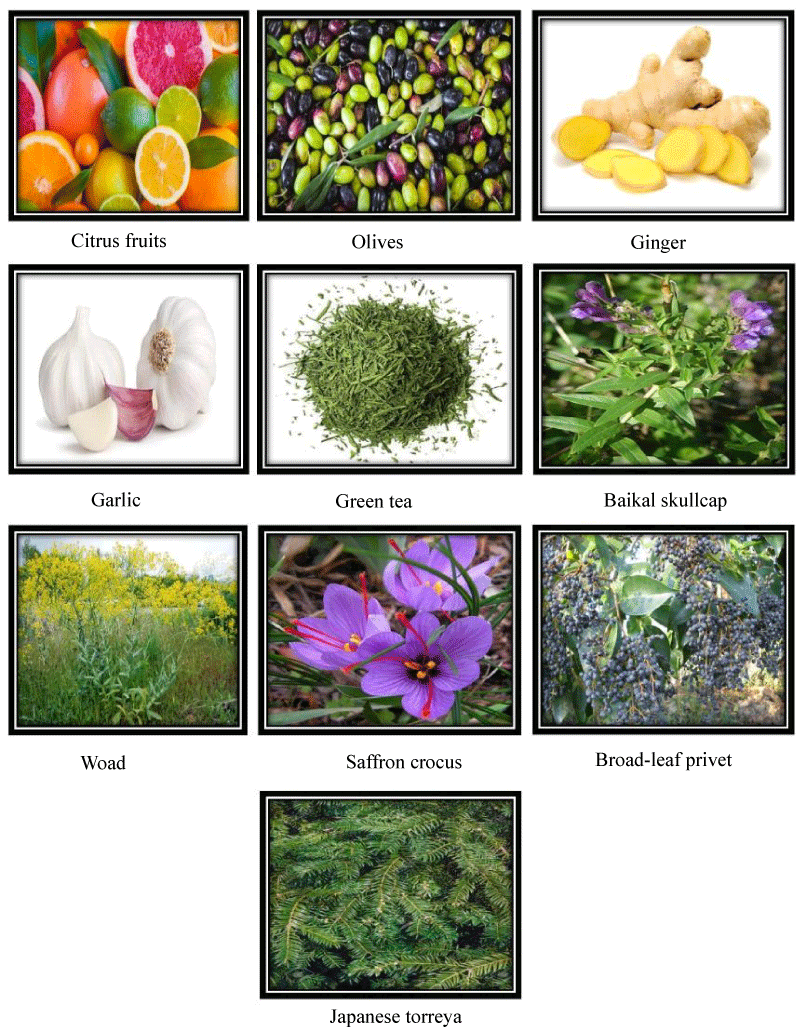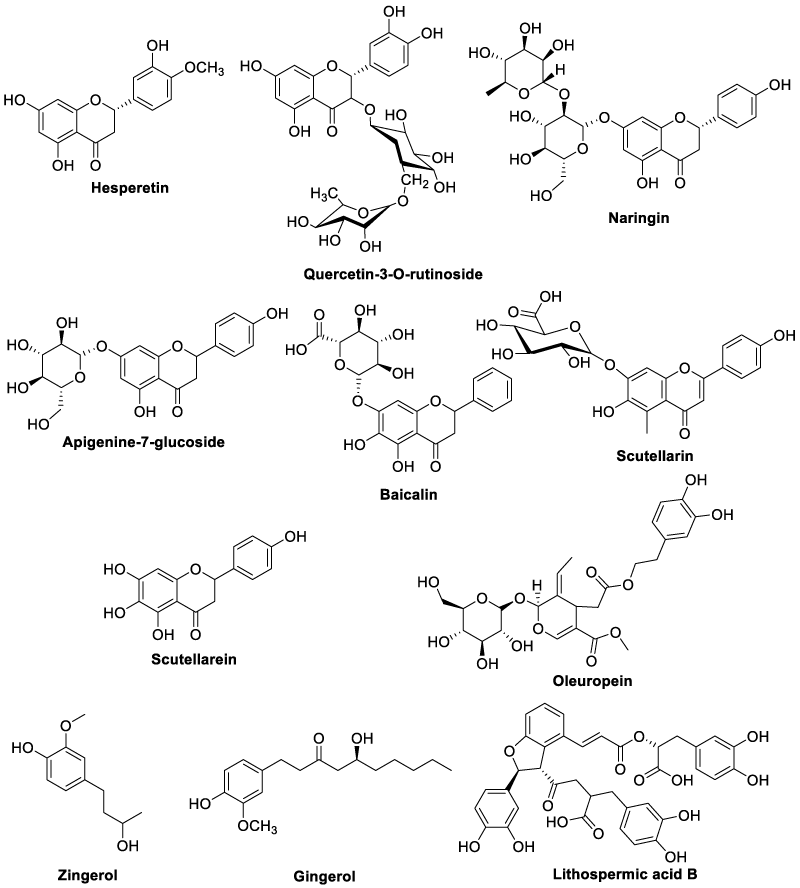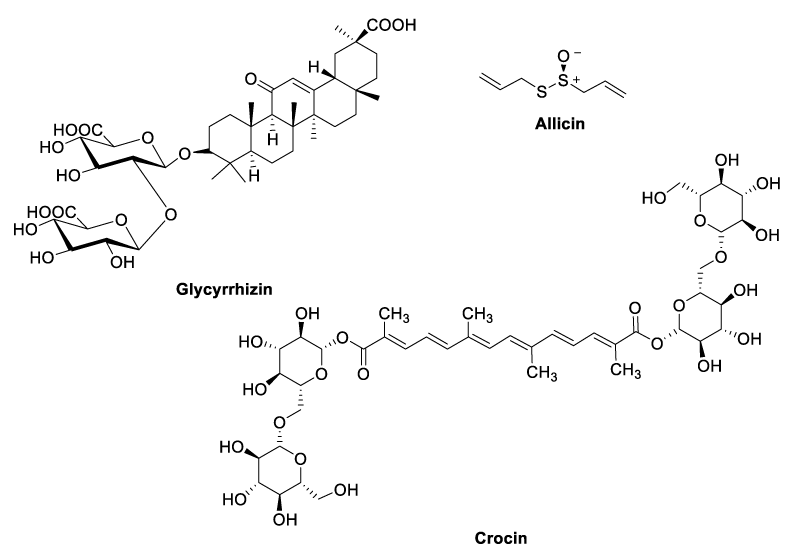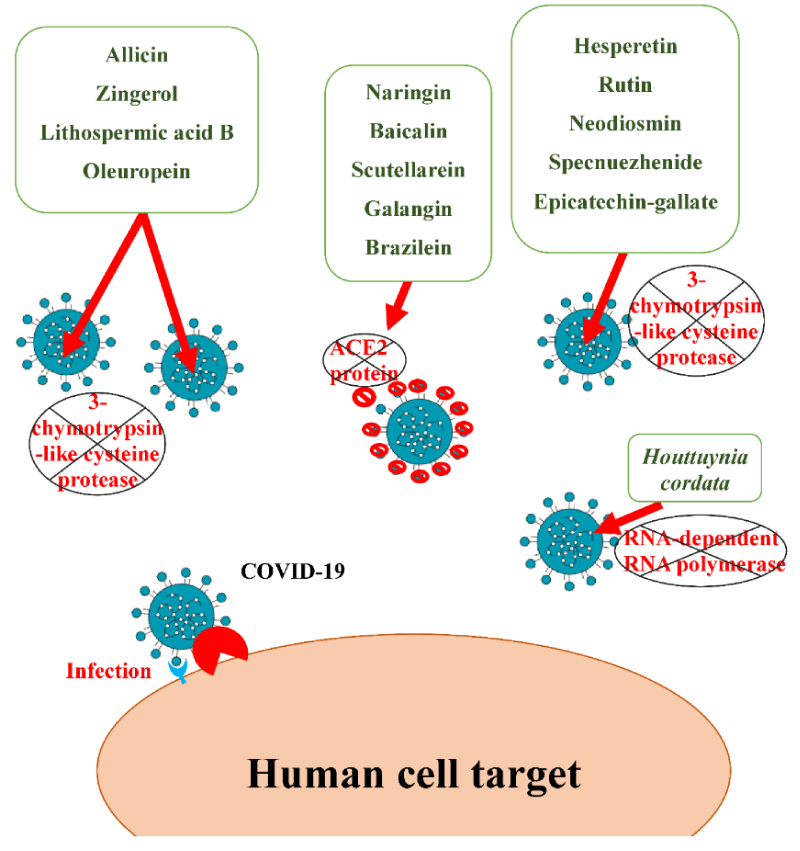More Information
Submitted: March 08, 2021 | Approved: March 22, 2021 | Published: March 23, 2021
How to cite this article: Hamimed S, Jebli N, Hamimed R, Landoulsi A, Chatti A. Phytochemicals candidates as promising preventives and/or curatives for COVID-19 Infection: A brief review. Insights Biol Med. 2021; 5: 001-006.
DOI: 10.29328/journal.ibm.1001019
ORCiD: orcid.org/0000-0002-2649-6345
Copyright License: © 2021 Hamimed S, et al. This is an open access article distributed under the Creative Commons Attribution License, which permits unrestricted use, distribution, and reproduction in any medium, provided the original work is properly cited.
Keywords: COVID-19; Phytochemicals; Traditional medicinal plants; Quercetin; Oleuropein; Crocin
Phytochemicals candidates as promising preventives and/or curatives for COVID-19 Infection: A brief review
Selma Hamimed1*, Nejib Jebli2, Rayene Hamimed3, Ahmed Landoulsi1 and Abdelwaheb Chatti1
1Laboratory of Biochemistry and Molecular Biology, University of Carthage, Faculty of Sciences of Bizerte, CP 7021-Jarzouna, Tunisia
2Laboratory of Hetero-Organic Compounds and Nanostructured Materials, University of Carthage, Faculty of Sciences of Bizerte, CP 7021-Jarzouna, Tunisia
3Laboratory of Bioactive Molecules and Applications, Department of Applied Biology, University of Tebessa, Tebessa, Algeria
*Address for Correspondence: Selma Hamimed, Department of Biology, Faculty of Sciences of Bizerte, University of Carthage, Tunisia, Tel: +21695513232; Email: [email protected]
The outbreak of new coronavirus acute respiratory disease (SARS-CoV-2) has been a major global challenge for the scientific community to save humanity. While, the unviability of the vaccine keeps most classes of society, especially African countries, suffer from the healthcare problem. Conventional medicine plants become the alternative method for the therapeutic because it contains valuable bioactive compounds. This brief review devoted the importance of medicinal plants such as Citrus, olive, garlic, ginger, green tea, woad, broad-leaf privet, Japanese torreya, and saffron crocus, by their antiviral effects (anti-SARS coronavirus, anti-HSV, and anti-HIV diseases) and their promising uses as probable boosters of the immune and anti-inflammatory response from SARS-CoV-2 infection. Based on scientific reports, bioactive compounds could inhibit 3-chymotrypsin-like cysteine protease and human protein ACE2, where these facts can be attractive to develop effective drugs.
A new severe pandemic pneumonia generated from a large seafood and animal market in the city of Wuhan (China) on December 2019 killed thousands of people around the world [1].
As of May 10, 2020, 61,165 cases confirmed and 2,239 deaths have been reported in Africa [2]. The spread out of this pandemic in Africa raise fears of the worst. In terms of healthcare, these countries face a large number of challenges, including lack of funds and poor infrastructures [3]. Besides, the availability of the vaccine or drug, if there is, will not be accessible to all layers of society.
Human coronavirus disease (COVID-19 or SARS-CoV-2) presents a severe acute respiratory, fever, dry cough, shortness of breath, fatigue and decreases of white blood cells and kidneys function. SARS-CoV-2 is an enveloped virus, classified in the beta-corona viruses group with a single-stranded positive-sense RNA genome and high nucleotide similarity (89%) with SARS coronavirus (SARS-CoV) genes [4]. The viral 3-chymotrypsin-like cysteine protease is the major protease produced by the SARS-CoV-2 that plays a key role in the production of functional viral proteins, which maintains the virus replication [5]. This protease shares 96% of similarity with SARS coronavirus protease [6]. Studies showed that the receptor-binding domain of COVID-19 strongly interacts with type I integral membrane human protein ACE2, where it is easily able to enter the host cells [7]. Treatment of COVID-19 remains a big challenge and more attention due to (i) the adaptation of virus, (ii) the resistance of SARS-CoV-2 to antiviral drugs and (iii) the possible development of new viral and bacterial strains [1].
Currently, SARS-CoV-2 is treated using chloroquine and hydroxychloroquine knowing for their ability to inhibit the SARS coronavirus and to treat HIV infections [8]. Scientists believed that both drugs can inhibit the ACE2 protein, but their risk of toxicity and side effects is of great concern [8].
For decades, medicinal plants have gained wide popularity due to their beneficial effect in treating various diseases. All civilizations around the globe offer unlimited sources of traditional plants and herbs that provide numerous phytochemicals compounds used in pharmaceutical industry. Meanwhile, over than 40% of natural products have been used in the synthesis of pharmaceutical drugs [9]. Virtually, the use of medicinal plants or their phytochemicals have gained an attractive interest to prevent and to treat the viral infections. It was well established that the main antiviral mechanisms of natural compounds are the inhibition of viral replication, assembly of intracellular particles, RNA polymerase, viral neuraminidase, protease, reverse transcriptase and viral protein expression [10]. As well as, many traditional medicinal plants have shown promising results in treating the coronavirus as shown in figure 1 [11-13]. Moreover, phytochemicals compounds have shown their direct antiviral impact and their ability to biosynthesis nanoparticles with promising antiviral activity [1,14,15]. These facts can be attractive to develop effective drugs much safer than chemical drugs.
This brief-review will provide information on the most effective medicinal plants in the treatment of coronavirus, as well as the mechanism in silico of their phytochemicals compounds against SARS-CoV-2 infection.
Figure 1: Some common medicinal plants and fruits.
Literatures were collected from the online bibliographical databases: PubMed, Scopus, Google Scholar, and Web of Sciences. The following keywords were used to search recent papers: “anti-coronavirus”, “antiviral activity”, “medicinal plants”, “COVID-19”, “phytochemical compounds”, “bioactive compounds”, “anti-SARS activity”, “anti-HIV”, and “Anti-HSV”. In this brief review, we cited forty-three papers that are tightly correlated with the main objective of this work.
Medicinal plants and their bioactive compounds
1. Citrus sp [mandarin orange, sour orange, pomelo, and sour orange]
Several Citrus fruits such as Citrus aurantium (Sour orange), Citrus grandis (Pomelo), Citrus reticulate (Mandarin orange), and Citrus sinensis (Sweet orange) are rich in flavonoids compounds, which are highly recommended to block beta coronavirus (Figure 2) [13]. Hesperetin, a major flavonoid, has showed an anti-SARS-coronavirus activity through the inhibition of 3-chymotrypsin-like cysteine protease [16]. In addition, rutin (quercetin-3-O-rutinoside) and neodiosmin have revealed an inhibition of the 3-chymotrypsin-like cysteine protease [5]. Thereby, naringin and rutin were used to prevent and decrease plasma cytokines levels of TNF-α, IL-1β, IL-10, IFNɤ in-patient with SARS-CoV-2. Moreover, naringin and hespertin revealed a potential binding with the ACE2 protein, which could prevent COVID-19 infection [17].
Figure 2: Chemical structure of flavonoids (hesperetin, quercetin 3-O-rutinoside, naringin, apigenine-7-glucoside, baicalin, scutellarin, scutellarein), tannins (oleuropein), simple and polyphenolic compounds (zingerol, gingerol, lithospermic acid B).
2. Olea europaea L [Olive]
Olea europaea is among the oldest trees grown in the world known by its therapeutic properties. The bioactive compounds extracted from Olea europaea fruits such as oleuropein, apigenin-7-glucoside, and luteolin-7-glucoside showed a potential inhibition of SARS-CoV-2 infection pathway through blocking the 3-chymotrypsin-like cysteine protease [6].
3. Glycyrrhiza glabra [Liquorice]
Liquorice has been used clinically for centuries in several therapeutic applications. The glycyrrhizin (Figure 3), bioactive substance extracted from liquorice plant, showed a clinical anti SARS-CoV activity by affecting the cellular signalling pathways like protein kinase C, casein kinase II, and nuclear factor in SARS-CoV [11].
Figure 3: Chemical structure of saponins (glycyrrhizin), organosulfur compounds (allicin), and carotenoids (crocin).
4. Scutellaria baicalensis [Baikal skullcap]
The baicalin extracted from the herbs of Scutellaria baicalensis has been reported as potential inhibitor of SARS-CoV infection within only 48 hours [1]. Moreover, another study showed that baicalin inhibited the angiotensin-I converting enzyme (ACE) [18]. Recently, scientists have reported that baicalin (at concentration of 2.24 Mm) could potentially inhibit ACE2 by binding to ASN-149, ARG-273, HIS-374, HIS-378, HIS-505, and ALA-348 sites [1,17].
Natural compounds of Baikal skullcap (Figure 2), such as scutellarein has showed potent inhibition of SARS-CoV helicase by affecting the activity of ATPase [19]. Besides, the scutellarin compound was revealed as promising agent to prevent SARS-CoV-2 infection by inhibiting ACE2 [1].
5. Lycoris radiate [Red spider lily]
Li, et al. [20] reported that the stem cortex of the Lycoris radiata herbs has potent antiviral activities against coronavirus (SARS-CoV) at a concentration of 15.7 nM. These results indicate that lycorine may be an alternative candidate to prevent or treat SARS-CoV-2 infection, since it shared similarity with the SARS virus (Table 1).
| Table 1: Sources and bioactivity of phytochemical compounds and in silico its target sites on SARS-CoV-2. | ||||
| Phytochemical compounds | Plants source | Bioeffects | Target sites in silico SARS-CoV-2 (Inhibition) | References |
| Hesperetin | Isatis indigotica Citrus sp | Antioxidant, Anti-inflammatory, Anti-HSV type 1, Anti- poliovirus type 1, Anti-parainfluenza virus type 3, and influenza |
3-chymotrypsin-like cysteine protease | [31,32] |
| Bananin | Banana | Inhibition of viral replication | ATPase inhibitor of the SARS-CoV-2 helicase. | [33] |
| Naringin | Citrus sp | Anti-rotavirus infection, Anti-inflammatory, Anti-carcinogenic | ACE2 protein, Interfere in levels of TNF-α, IL-1β, IL-10, IFNɤ |
[17,31,32,34] |
| Baicalin | Scutellaria baicalensis | Anti-HSV type 1 and 2 Anti-adenoviruses |
ACE2 protein | [1,17,35] |
| Quercetin-3-O-rutinoside | Citrus sp | Antiviral, Anti-inflammatory, Antioxidant | 3-chymotrypsin-like cysteine protease | [5,36] |
| Neodiosmin | Citrus sp | Not reported | [5] | |
| Oleuropein, Apigenin-7-glucoside | Olea europaea | Antiviral, Anti-atherogenic, Anti-inflammatory, Antioxidant, Anti-leukemia | 3-chymotrypsin-like cysteine protease | [6,37,38] |
| Crocin | Crocus Sativus | Anti-HSV and Anti-HIV |
COVID-19 spike protein | [25,26] |
| Allicin | Allium sativum | Antioxidant, Antiviral, Hypolipidemic | 3-chymotrypsin-like cysteine protease | [6,39] |
| Scutellarein, Scutellarin | Scutellaria baicalensis | Antioxidant, Anti-inflammatory, Antiviral | Helicase protein, ACE2 protein | [1,40] |
| Zingerol, Gingerol | Zingiber officinale | Anti-inflammatory, immunomodulatory properties, Antioxidant | 3-chymotrypsin-like cysteine protease | [6,41] |
| Kaempferol | Spinacia oleracea, Brassica oleracea, Anethum graveolens, Brassica rapa, Sauropus androgynus | Inhibit transcription with RNA polymerase II, Antioxidant | 3-chymotrypsin-like cysteine protease | [6,42] |
6. Allium sativum [Garlic]
The garlic is widely consumed due to its bioactive compounds richness. As show in figure 3, allicin is one of the most bioactive compounds with high activity against SARS-CoV-2 through the inhibition of 3-chymotrypsin-like cysteine protease [6].
7. Isatis indigotica [Woad]
The anti-SARS coronavirus activity was investigated by using Isatis indigotica root extract and plant-derived phenolic compounds. It showed that hesperetin from this plant inhibited the 3-chymotrypsin-like cysteine protease, which blocks the coronas virus [16].
8. Houttuynia cordata Thunb [Saururaceae]
The Houttuynia cordata (Saururaceae) is widely used in Chinese medicine to treat SARS disease. The saururaceae extract proved a varied inhibitory effect on SARS coronavirus 3-chymotrypsin-like cysteine protease and RNA-dependent RNA polymerase [21].
9. Ligustrum lucidum [Broad-leaf privet]
Phytochemicals isolated from Ligustrum lucidum fruits known by their richness of bioactive compounds. Of particular interest, specnuezhenide and neonuezhenide, which belong to secoiridiod glycosides class. These compounds have showed potent inhibitory activity against 3-chymotrypsin-like cysteine protease through binding to conventional hydrogen bonds, carbon hydrogen bonds, van der Waals force, and hydrophobic interaction [5].
10. Zingiber officinale [Ginger]
Ginger is frequently used in food and traditional medicine. Bioactive compounds from ginger, such as zingerol and gingerol (Figure 2), have shown an inhibition of 3-chymotrypsin-like cysteine protease in SARS-CoV-2 infection [6].
11. Salvia miltiorrhiza [Chinese sage herb]
Salvia miltiorrhiza knows as Chinese sage herb, is widely used in Chinese traditional medicine. Lithospermic acid B is one of the polyhydroxy phenolic acid compounds isolated from this herb. This bioactive substance has been reported as a potential candidate to inhibit the 3-chymotrypsin-like cysteine protease in SARS-CoV-2 [5].
12. Torreya nucifera [Japanese torreya]
Torreya nucifera is an ancient tree used for decades in traditional Asian medicine. The ethanol extract of T. nucifera leaves exhibited good activity against SARS coronavirus. Three bioflavonoids from T. nucifera (apigenin, luteolin, and quercetin) have demonstrated a potential inhibitory activity of 3-chymotrypsin-like cysteine protease [22].
13. Cupressus sempervirens L [Cypress]
The hydro-ethanolic extract from fresh cones of cypress (Cupressus sempervirens L) has been tested against Corona VR-740. The study revealed a massive amount of bioactive molecules in cypress extract, such as catechin, epicatechin, tannins of proanthocyanidin, and flavonoids that inhibited the coronavirus activity within 60 min [23].
14. Laurus nobilis [Bay tree]
The essential oil of Laurus nobilis berries was also found to be potent against corona viruses. The presence of ß-ocimene and 1.8-cineole in sweet bay berries oil gave an interesting anti SARS-CoV activity [24].
15. Crocus Sativus L [Saffron crocus]
The flower of saffron crocus contains considerable amount of natural bioactive compounds like crocin, which is known as anti-HSV (Herpes simplex virus) and anti-HIV (human immunodeficiency viruses) agents (Table 1) [25,26]. A recent study revealed that crocin demonstrated good interaction with the receptor of SARS-CoV-2, similar to chloroquine [25].
16. Phytochemical compounds as Anti- SARS-CoV-2
Various phytochemical compounds proved to be promising in preventing and treating SARS-CoV-2 infection, are cited as follow: Amaranthin of (Amaranthus tricolor), Demethoxycurcumine of (Curcuma longa and Curcuma xanthorriza), Kaempferol of (Spinacia oleracea), Licoleafol of (Glycyrrhiza uralensis), Myricitrin, Myricetin 3-O-beta-D-glucopyranoside, 3,5,7,3’,4’,5’- hexahydroxy flavanone-3-Obeta- D-glucopyranoside of (Myrica cerifera), Methylrosmarinate, Calceolarioside B of (Fraxinus Sieboldiana), 5,7,3’,4’-Tetrahydroxy-2’-(3,3-dimethylallyl) isoflavone of (Psorothamnus arborescens), (2S)-Eriodictyol 7-O-(6’’-Ogalloyl)-beta-D-glucopyranoside and Epicatechin-gallate of (Green tea). These phytochemicals have found to be active against 3-chymotrypsin-like cysteine protease in SARS-CoV-2 [4,6]. In addition, Brazilein and Galangin extracted from Caesalpinia sappan and Alpinia galanga, respectively inhibited the ACE2 protein (Figure 4) [13]. Hence, we assumed that the compounds of flavonoid derivatives appear to be the most effective natural agents in inhibiting COVID-19 infection. As quercetin and its derivate found to be effective in blocking of SARS-CoV helicase activity by inhibiting the duplex DNA-unwinding activity, the ACE2 protein, and the 3-chymotrypsin-like cysteine protease activity. Similarly, luteolin, psoralidin, neobavaisoflavone, catechin, tomentin and its derivate could be served as a potential drug with the papain-like protease activity and acting as proteolytic agent against viral infections [27]. Therefore, the quercetin, catechin, genistein, and taxifolin molecules are acting as inducers of metallothioneins, especially Zn-ionophores, which showed potential antiviral properties and promising for the SARS-CoV-2 treatment [28].
Figure 4: Recapitulative target sites of phytochemicals compounds against SARS-CoV-2 infection.
Moreover, from a biological and pharmacological point of view, it is very important to note the vital activity of the avarol molecule extracted from marine sponge Dysidea avara Schmidt in some pharmacological effects such as HIV-like infections [29]. The derivatives of this molecule can also inhibit acetyl cholinesterase activity and could be a promising in neurodegenerative disorders such as Alzheimer’s disease [30 ].
The current review summarized the principal medicinal plants and their phytochemicals compounds that have been screened in silico as promising preventive and curative candidate against SARS-CoV-2 infection. While, flavonoids showed the most potent activity. The main target sites of these compounds are the inhibition of 3-chymotrypsin-like cysteine protease, ACE2 protein, and viral replication. Overall, it is necessary to conduct further investigations to verify the in vivo potentiality of these phytochemicals compounds on SARS-CoV-2 infection. As well as, the interest should be taken on the use of bio-nanomaterials to benefit from the precise and high effect of the bioactive molecule.
Author contributions
SH, NJ, and RH were responsible for the writing of the manuscript. AL corrected the manuscript. AC designed, corrected, and approved the manuscript.
This work was supported by the Tunisian Ministry of Higher Education and Scientific Research; Faculty of Sciences of Bizerte- Biology Department.
- Chen H, Du Q. Potential natural compounds for preventing 2019-nCoV infection. 2020; 1-16.
- Africa CDC. https://au.int/fr/covid19
- Ananlysis-COVID-19 pandemic: Great danger awaits Africa. 2020. https://www.aa.com.tr/en/africa/analysis-covid-19-pandemic-great-danger-awaits- africa/1789840
- Qamar MT, Alqahtani SM, Alamri MA, Chen LL. Structural basis of SARS-CoV-2 3CLpro and anti-COVID-19 drug discovery from medicinal plants. J Pharm Anal. 2020; 10: 313-319. PubMed: https://pubmed.ncbi.nlm.nih.gov/32296570/
- Sun N, Wong W, Guo J. Prediction of potential 3CLpro-targeting anti-SARS-CoV-2 compounds from Chinese Medicine. 2020; 1-13.
- Khaerunnisa S, Kurniawan H, Awaluddin R, Suhartati S, Soetjipto S. Potential inhibitor of COVID-19 main protease (Mpro) from several medicinal plant compounds by Molecular Docking Study. 2020; 1-14.
- Letko M, Munster V. Functional assessment of cell entry and receptor usage for lineage B? -coronaviruses, including 2019-nCoV. BioRxiv. 2020; 1-26.
- Frie K, Gbinigie K. Chloroquine and hydroxychloroquine: Current evidence for their effectiveness in treating COVID-19. CEBM-University of Oxford. 2020.
- Jassim SAA, Naji MA. Novel antiviral agents: a medicinal plant perspective. J Appl Microbiol. 2003; 95: 412-427. PubMed: https://pubmed.ncbi.nlm.nih.gov/12911688/
- Amber R, Adnan M, Tariq A, Mussarat S. A review on antiviral activity of the Himalayan medicinal plants traditionally used to treat bronchitis and related symptoms. J Pharm Pharmacol. 2016; 69: 109-122. PubMed: https://pubmed.ncbi.nlm.nih.gov/27905101/
- Cinatl J, Morgenstern B, Bauer G, Chandra P, Rabenau H, et al. Glycyrrhizin, an active component of liquorice roots, and replication of SARS-associated coronavirus. Lancet. 2003; 361: 2045-2046. PubMed: https://pubmed.ncbi.nlm.nih.gov/12814717/
- Chen Z, Nakamura T. Statistical evidence for the usefulness of Chinese medicine in the treatment of SARS Phytother. Res J. 2004; 18: 592-594. PubMed: https://pubmed.ncbi.nlm.nih.gov/15305324/
- Utomo RY, Ikawati M, Meiyanto E. Revealing the potency of Citrus and galangal constituents to halt SARS-CoV-2 infection. 2020; 1-8.
- Hamimed S, Jebli N, Sellami H, Landoulsi A, Chatti A. Dual valorization of olive mill wastewater by bio-nanosynthesis of magnesium oxide and Yarrowia lipolytica biomass production. Chem. Biodivers. 2020; 17: e1900608. PubMed: https://pubmed.ncbi.nlm.nih.gov/32017363/
- Rafiei S, Rezatofighi SE, Ardakani MR, Madadgar O. In vitro anti-foot-and-mouth disease virus activity of magnesium oxide nanoparticles. IET. Nanobiotechnol. 2015; 9: 247-251. PubMed: https://pubmed.ncbi.nlm.nih.gov/26435276/
- Lin CW, Tsai FJ, Tsai CH, Lai CC, Wan L, et al. Anti-SARS coronavirus 3C-like protease effects of Isatis indigotica root and plant-derived phenolic compounds. Antiviral Res. 2005; 68: 36-42. PubMed: https://pubmed.ncbi.nlm.nih.gov/16115693/
- Cheng L, Zheng W, Li M, Huang J, Bao S, et al. Citrus fruits are rich in flavonoids for immune-regulation and potential targeting ACE2. 2020; 1-13.
- Deng YF, Aluko RE, Jin Q, Zhang Y, Yuan LJ. Inhibitory activities of baicalin against renin and angiotensin-converting enzyme. Pharm Bio. 2011; l50: 401-406. PubMed: https://pubmed.ncbi.nlm.nih.gov/22136493/
- Yu MS, Lee J, Lee JM, Kim Y, Chin YW, et al. Identification of myricetin and scutellarein as novel chemical inhibitors of the SARS coronavirus helicase nsP13. Bioorg Med Chem Lett. 2012; 22: 4049-4054. PubMed: https://pubmed.ncbi.nlm.nih.gov/22578462/
- Li S, Chen C, Zhang H, Guo H, Wang H, et al. Identification of natural compounds with antiviral activities against SARS-associated coronavirus. Antivir Res. 2005; 67: 18-23. PubMed: https://pubmed.ncbi.nlm.nih.gov/15885816/
- Lau KM, Lee KM, Koon CM, Cheung CS, Lau CP, et al. Immunomodulatory and anti?SARS activities of Houttuynia cordata. J Ethnopharmacol. 2008; 118: 79-85. PubMed: https://pubmed.ncbi.nlm.nih.gov/18479853/
- Ryu YB, Jeong HJ, Kim JH, Kim YM, Park JY, et al. Biflavonoids from Torreya nucifera displaying SARS CoV 3CL(pro) inhibition. Bioorg Med Chem. 2010; 18: 7940-7947. PubMed: https://pubmed.ncbi.nlm.nih.gov/20934345/
- Guinobert I, Bardot V, Berthomier L, Ripoche I, Faivre C, et al. In vitro virucidal activity of an extract of cypress on human and bovine viruses. Phytothérapie. 2018; 16: 281-289.
- Loizzo M, Saab A, Tundis R, Menichini F, Lampronti I, et al. Phytochemical analysis and in vitro antiviral activities of the essential oils of seven lebanon species. Chem Biodivers. 2008; 5: 461-470. PubMed: https://pubmed.ncbi.nlm.nih.gov/18357554/
- Aanouz I, Belhassan A, El-Khatabi K, Lakhlifi T, El-ldrissi M, et al. Moroccan Medicinal plants as inhibitors against SARS-CoV-2 main protease: Computational investigations. J Biomol Struct Dyn. 2020; 6: 001-009. PubMed: https://pubmed.ncbi.nlm.nih.gov/32306860/
- Mohd Kasim NA, Ain Abu Bakar N, Ahmad R, Abd Rahim IN, Hasrah Abdul Rahman T, et al. Crocus Sativus and Its Active Compound, Crocin Inhibits the Endothelial Activation and Monocyte-Endothelial Cells Interaction in Stimulated Human Coronary Artery Endothelial Cells. BioRxiv. 2020; 1-23.
- Prasansuklab A, Theerasrib A, Rangsinth P, Sillapachaiyaporn S, Chuchawankul S, et al. Anti-COVID-19 drug candidates: A review on potential biological activities of natural products in the management of new coronavirus infection. J Tradit Complement Med. 2021; 11: 144-157.
- Rahman MT, Idid SZ. Can Zn Be a Critical Element in COVID-19 Treatment? Biological Trace Element Research. 2020. PubMed: https://pubmed.ncbi.nlm.nih.gov/32458149/
- Pejin B, Iodice C, Tommonaro G, De Rosa S. Synthesis and Biological Activities of Thio-avarol Derivatives. J Nat Prod. 2008; 71: 1850-1853. PubMed: https://pubmed.ncbi.nlm.nih.gov/19007183/
- Tommonaro G, García-Font N, Vitale RM, Pejin B, Iodice C, et al. Avarol derivatives as competitive AChE inhibitors, non hepatotoxic and neuroprotective agents for Alzheimer's disease. Eur J Med Chem. 2016; 122: 326-338. PubMed: https://pubmed.ncbi.nlm.nih.gov/27376495/
- Ding HW, Huang AL, Zhang YL, Li B, Huang C, et al. Design, synthesis and biological evaluation of hesperetin derivatives as potent anti-inflammatory agent. Fitoterapia. 2017; 121: 212-222. PubMed: https://pubmed.ncbi.nlm.nih.gov/28774689/
- Paredes A, Alzuru M, Mendez J, Rodríguez-Ortega M. Anti-Sindbis Activity of Flavanones Hesperetin and Naringenin. Biol Pharm Bull. 2003; 26: 108-109. PubMed: https://pubmed.ncbi.nlm.nih.gov/12520185/
- Tanner JA, Zheng BJ, Zhou J. The adamantane-derived bananins are potent inhibitors of the helicase activities and replication of SARS coronavirus. Chem Biol. 2005; 12: 303-311. PubMed: https://pubmed.ncbi.nlm.nih.gov/15797214/
- Nafisi S, Shadaloi A, Feizbakhsh A, Tajmir-Riahi HA. RNA binding to antioxidant flavonoids. J Photoch Photobio B. 2009; 94: 1-7. PubMed: https://pubmed.ncbi.nlm.nih.gov/18922698/
- Chiang LC, Chiang W, Chang MY, Ng LT, Lin CC. Antiviral activity of Plantago major extracts and related compounds in vitro. Antivir Res. 2002; 55: 53-62. PubMed: https://pubmed.ncbi.nlm.nih.gov/12076751/
- Yang J, Guo J, Yuan J. In vitro antioxidant properties of rutin. LWT-Food Sci Technol. 2008; 41: 1060-1066.
- Haris Omar S. Oleuropein in Olive and its Pharmacological Effects. Sci Pharm. 2010; 78: 133-154. PubMed: https://pubmed.ncbi.nlm.nih.gov/21179340/
- Samet I, Villareal MO, Motojima H, Han J, Sayadi S, et al. Olive leaf components apigenin 7-glucoside and luteolin 7-glucoside direct human hematopoietic stem cell differentiation towards erythroid lineage. Differentiation. 2015; 89: 146-155. PubMed: https://pubmed.ncbi.nlm.nih.gov/26299581/
- Ilić D, Nikoli V, Stankovi M, Nikoli L, Stanojevi L, et al. A Transformation of synthetic allicin: the influence of ultrasound, microwaves, different solvents and temperatures, and the products isolation. Sci World J. 2012; 2012: 561823. PubMed: https://pubmed.ncbi.nlm.nih.gov/22629145/
- Li J, Tian C, Xia Y, Mutanda I, Wang K, et al. Production of plant-specific flavones baicalein and scutellarein in an engineered E. coli from available phenylalanine and tyrosine. Metab Eng. 2018; 124-133. PubMed: https://pubmed.ncbi.nlm.nih.gov/30496827/
- Onu PN. Evaluation of two herbal spices as feed additives for finisher broilers. Biotech Animal Husbandry. 2010; 26: 383-392.
- Kanakis CD, Tarantilis PA, Polissiou MG, Diamantoglou S, Tajmir-Riahi HA. DNA Interaction with Naturally Occurring Antioxidant Flavonoids Quercetin, Kaempferol, and Delphinidin. J Biomol Struct Dyn. 2005; 22: 719-724. PubMed: https://pubmed.ncbi.nlm.nih.gov/15842176/
- Chen F, Chan KH, Jiang Y, Kao RY, Lu HT, et al. In vitro susceptibility of 10 clinical isolates of SARS coronavirus to selected antiviral compounds. J Clin Virol. 2004; 31: 69-75. PubMed: https://pubmed.ncbi.nlm.nih.gov/15288617/



